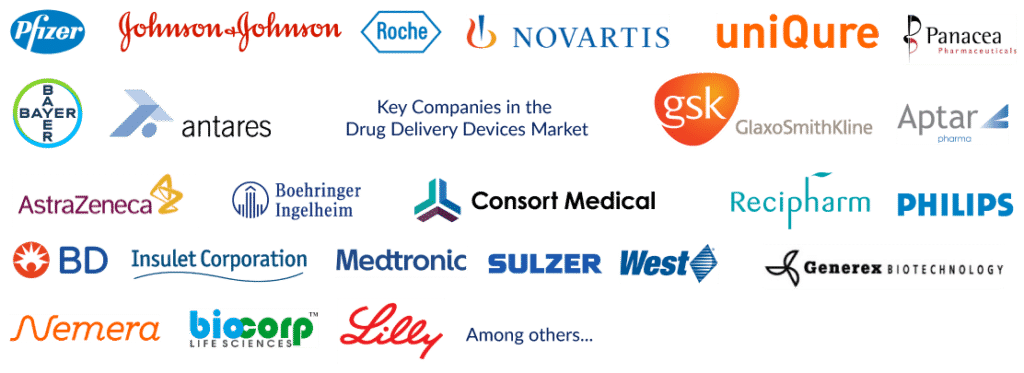How Are Innovations in Drug Delivery Devices Solving the Complex Challenges in the Market?
Jan 18, 2023
Table of Contents
Drug delivery is one of the highly evolving topics in the healthcare industry. Over the past few decades, there has been enormous growth in the drug delivery devices market owing to the active participation of the global MedTech giants, the rise in investments, and technological advancements in the development of new devices and drug modifications. As per DelveInsight’s assessment, the global drug delivery devices market is anticipated to grow at a CAGR of 7.90% during the forecast period from 2022 to 2027. Moreover, some of the key factors, such as the rising number of patients suffering from diabetes, the growing prevalence of cancer, and the rising growth of biologics, are also immensely stimulating the drug delivery devices market growth.
Drug Delivery Devices – An Overview
A drug delivery system is defined as a formulation or device which presents a drug to the body for administration and absorption. Drug delivery devices are highly specialized tools for delivering a drug or therapeutic agent via a specific route of administration into or throughout the body. It is being observed that apart from the pharmaceutical compounds of the drug, the efficacy and the effectiveness can be impacted immensely by how it is being delivered in the body. With innovation and new technologies, delivering a drug into the body is getting much easier, accurate, and it also requires less frequent dosing. Different techniques and methods are being adopted to ensure targeted and controlled drug delivery, such as encapsulation, biomarkers, and artificial nanocarriers. Moreover, the drugs are being developed to selectively target the specific site with decreased variability in systemic drug concentrations. The enormous growth of nanotechnology is also paving the way for the development of advanced drug delivery systems that have much more precision and control over the release of drugs.
Downloads
Click Here To Get the Article in PDF
Recent Articles
- From Lab to Bedside: The Rise of AI-Enabled Digital Pathology
- Olympus Launches New Gynecologic Power Morcellator; Journey Biosciences Launched NaviDKD; GE Boar...
- GE HealthCare’s CARESCAPE Canvas Patient Monitoring Platform; Medtronic’s MiniMed™ 780G Sy...
- Epredia Announced the US Launch of SlideMate Laser; Olympus, Canon Medical Announced Partnership;...
- Who is Going to be a Trendsetter in the Hereditary Deafness Market?
Drug Delivery Devices Types
Drug delivery is the process of administering medication or other pharmaceutical compounds to attain a desired therapeutic effect on the body part. There are various anatomical routes to introduce the drug into the body. They may be intended for systemic effects or to target various organs and diseases. The selection of the route of administration depends on various factors such as the disease, the effect desired, and the product available. Drugs may be administered directly to the organ affected by disease or given systemically to target the diseased organ. The drug delivery devices can be segmented by the type of devices, such as implantable, inhalers, nebulizers, safety syringes, transdermal patches, and others. Similarly, by the route of administration, the drug delivery devices are segmented as oral, inhalation, transdermal, injectable, and ocular drug delivery devices.
As per DelveInsight’s assessment, in the route of administration segment of the drug delivery devices market, the injectable category holds a significant share of the market revenue. Some of the key factors, such as the rising product approvals and the growth in the research and development associated with injectable devices, are anticipated to lead to higher growth of injectable delivery devices. Injectables are also acquiring a major market share as they help deliver larger molecules, such as biologics, that are well-administered by injectables alone, given their size, profile, and viscosity.
Drug Delivery Devices Market Dynamics
As per DelveInsight, the drug delivery devices market is expected to grow in the coming years, owing to various factors. One of the important factors is the growing prevalence of patients affected with chronic diseases such as diabetes. The rising prevalence of diabetes across the globe is anticipated to contribute immensely to the increase in the demand for drug-delivery devices due to the use of the devices in treating diabetes. Furthermore, the rising number of patients affected with cancer will also increase the demand for drug delivery devices. Despite several favorable factors, some of the key aspects, such as stringent regulatory policies pertaining to drug delivery devices and the lessened adoption of patients for drug delivery devices, may restrict the drug delivery devices market growth.
Key Companies in the Drug Delivery Devices Market and Regional Market Assessment
Globally, some of the leading MedTech players in the drug delivery devices market include Pfizer, Inc, Johnson & Johnson Services, Inc, F. Hoffmann-La Roche, Ltd, Novartis AG, 3M Bayer AG, uniQure N.V., Shenzhen (SiBiono) GeneTech Co. Ltd (Hubei Tongji Benda Ebei Pharmaceuticals), Antares Pharma, Inc, GlaxoSmithKline plc, AstraZeneca PLC, Becton Dickinson, Boehringer Ingelheim group, Consort Medical plc (Recipharm Group), Insulet Corporation, Medtronic Plc, Sulzer Ltd., West Pharmaceuticals Services, Inc, Generex Biotechnology, Panacea Pharmaceuticals Inc., Aptar Pharma, Koninklijke Philips N.V., Nemera, Biocorp Production., and Eli Lilly and Co. and others.

As per DelveInsight’s assessment, amongst all the regions, North America is estimated to account for the largest share of the drug delivery devices market. The rise in the prevalence of chronic diseases, such as diabetes, increase in the number of cancer across the region is driving the demand for drug-delivery devices, leading to an overall rise in the drug-delivery devices market growth. Moreover, the growth in research and development activities, increasing usage of biologics, the rising use of medication delivery systems in home-care settings, growing approvals for drug delivery devices coupled with increasing focus of the government in terms of providing access to healthcare services are also anticipated to contribute immensely to the market growth in the North America regions. A very high chronic and non-chronic disease burden and an aging population present opportunities for drug delivery device manufacturers to enter emerging markets.
Key Development in the Drug Delivery Devices Market
In recent years, several major clinical, commercial, and regulatory developments have been registered in the drug delivery devices market. Some of the major advances in the market include –
- In October 2022, Vivera announced that its exclusive global license to the novel TABMELT® platform for pharmaceutical use had been extended in Israel.
- In October 2022, using the power of naturally occurring extracellular vesicles, Mercury Bio developed patent-pending technology that will enable highly targeted delivery of both RNA therapeutics and small-molecule drugs to diseased cells.
- In October 2022, ALCOR and Merck KGaA agreed to develop and supply a specific version of the Mallya device as an accessory for one of Merck KGaA, Darmstadt, Germany’s drug delivery devices.
- In December 2020, AireHealth earned the Food and Drug Administration 510(k) clearance for portable nebulizers.
- In September 2020, the Food and Drug Administration approved GSK’s three-drug asthma inhaler.
- In April 2020, FDA approved the first generic albuterol inhaler.
Drug Delivery Devices Market – Future Perspective and Key Insights
In the past few decades, drug delivery and drug targeting systems have registered dramatic growth. Due to the high demand, several new players are also anticipated to enter the market in the near future. Several new technologies and new modes of drug delivery are under different phases of development and are expected to enter clinical practice and improve the therapeutic outcome. Moreover, the growing trend of patient-friendly drug delivery measures that enhances the patient experience, the lowering cost of care, favorable reimbursement policies, and the rise in the living standard are immensely contributing to the demand for drug delivery devices. The advances in new technologies such as sensors, IoT, artificial intelligence, and others and their incorporation are further anticipated to increase the convenience and intuitiveness of systems and their adoption in the coming years.

Downloads
Article in PDF
Recent Articles
- Stereotaxis and Shanghai MicroPort EP Medtech Co., Ltd. Receives Approval for Magbot Robotic Magn...
- Stryker’s LIFEPAK 35 Monitor/Defibrillator; Qiagen’s QIAstat-Dx Respiratory Panel; Evolution Opti...
- Neuspera Medical’s Nuvella System; Abbott Presented the Data for FreeStyle Libre 2 System; ZEISS ...
- Medtronic Gains CE Mark for LigaSure™ on Hugo™ Robotic System; J&J Wins FDA Nod for VARIPULSE...
- Biosense Webster’s HELIOSTAR Radiofrequency Balloon Ablation Catheter; Philips’s ClarifEye Augmen...



